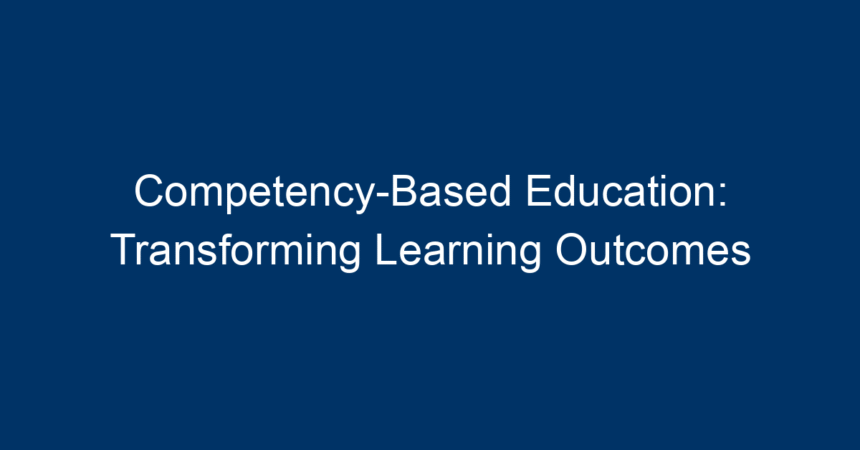In today’s rapidly changing world, the demand for skills and competencies is more significant than ever. Traditional education systems often struggle to keep pace with the evolving skill sets needed in the workforce. Enter competency-based education (CBE), a transformative approach that focuses on equipping students with the essential skills they need to succeed. This article delves into the principles of competency-based education, its impact on learning outcomes, and actionable insights for students, educators, and institutions alike.
Understanding Competency-Based Education
Competency-based education is an instructional approach that emphasizes the mastery of specific skills and knowledge before moving on to the next concept or unit. In contrast to traditional education, where learning is often time-bound and standardized, CBE allows students to progress at their own pace, ensuring that they fully understand the material.
Key Principles of Competency-Based Education
-
Learner-Centered: CBE places the learner at the core of the educational process. Instead of a one-size-fits-all approach, it tailors learning experiences to meet individual needs and interests.
-
Mastery of Skills: The focus on competencies means that students must demonstrate proficiency in specific skills before advancing. This ensures that all graduates possess the required abilities to succeed in their careers.
-
Flexible Learning Environment: Competency-based education often leverages technology, allowing for flexible learning options that can be tailored to fit various learning styles. Students can engage with the material in ways that suit them, whether through online courses, hands-on projects, or collaborative work.
- Real-World Application: CBE emphasizes the practical application of skills. Students are often involved in projects that mimic real-world scenarios, making their education relevant and applicable.
The Benefits of Competency-Based Education
Adopting a competency-based education model has numerous benefits for learners, educators, and institutions.
1. Enhanced Learning Outcomes
By emphasizing mastery, CBE leads to improved learning outcomes. Students are more likely to retain information when they have a thorough understanding of the material. Research indicates that CBE frameworks result in higher graduation rates and lower dropout rates, especially in non-traditional student populations.
2. Increased Engagement
Traditional educational systems can disengage students, particularly when they struggle to keep up with a rigid curriculum. CBE promotes student agency and autonomy, leading to increased motivation and engagement. When learners can progress at their own pace, they are more likely to take ownership of their education.
3. Skill Development
In a world where employers seek graduates with specific competencies, CBE helps students develop the skills that matter. This approach bridges the gap between education and employment, equipping students with relevant skills that are directly applicable in the workforce.
4. Accessibility
Competency-based education can also enhance accessibility. By offering flexible learning schedules and online options, CBE can meet the diverse needs of all learners, including adult learners, working professionals, and those with family responsibilities.
Implementing Competency-Based Education
To effectively implement a competency-based education model, institutions must focus on several key areas.
1. Curriculum Design
The curriculum must be designed around clear competencies that align with industry demands. Each competency should have well-defined learning outcomes and assessment methods. Collaborating with industry partners can help ensure that the competencies are relevant and up-to-date.
2. Assessment Methods
In CBE, assessment plays a critical role. Traditional grading systems may not adequately reflect student mastery. Instead, formative assessments, portfolios, and performance evaluations can be more effective in measuring competencies.
3. Technology Integration
Leveraging technology is essential for implementing CBE effectively. Learning management systems can facilitate personalized learning pathways, allowing students to access resources and track their progress. Virtual simulations and interactive tools can also enhance engagement and skill acquisition.
4. Faculty Training
Educators must be adequately trained to support CBE initiatives. Professional development programs should focus on creating learner-centered environments, designing competency-based assessments, and utilizing technology effectively.
Challenges in Competency-Based Education
While the benefits of competency-based education are clear, challenges can arise when implementing this educational model.
1. Resistance to Change
Traditional educational paradigms are deeply entrenched, and transitioning to a CBE framework may face resistance from faculty, administrators, and even students who are accustomed to conventional methods.
2. Resource Allocation
Developing and implementing a CBE program requires significant investment in technology, training, and curriculum development. Institutions may struggle to allocate sufficient resources to make a successful transition.
3. Quality Control
Ensuring the quality of competency-based programs is essential. Institutions must establish robust systems for monitoring student progress and outcomes to maintain standards.
Conclusion
Competency-based education is transforming the landscape of learning outcomes, making education more relevant, engaging, and effective. By focusing on mastery, fostering flexibility, and developing essential skills, CBE prepares students for the demands of the modern workforce.
For students and educators considering adopting this model, developing clear competencies and utilizing innovative assessment methods are crucial steps. With investment in technology and faculty training, institutions can create a learning environment that benefits all learners.
Actionable Insights
-
For Students: Take ownership of your learning journey. Seek out resources and opportunities to master competencies relevant to your career goals.
-
For Educators: Embrace the principles of CBE in your classrooms. Focus on developing clear competencies and assessments that reflect student mastery.
- For Institutions: Invest in technology and training to support CBE initiatives. Collaborate with industry partners to ensure curriculum relevance and prepare students for the future workforce.
Final Thoughts
In a world where adaptability and skill mastery are paramount, competency-based education stands out as a beacon of opportunity. By understanding its principles, benefits, and implementation strategies, all stakeholders in education can work together to foster true learning transformation. Embracing CBE can not only improve educational outcomes but can also inspire a new generation of learners ready to tackle the challenges of tomorrow.




